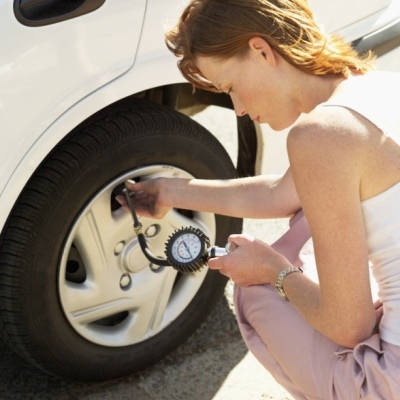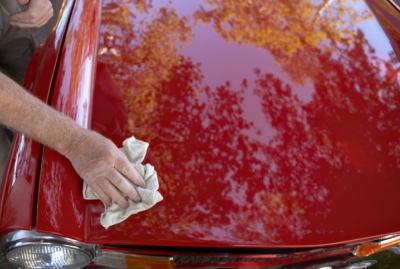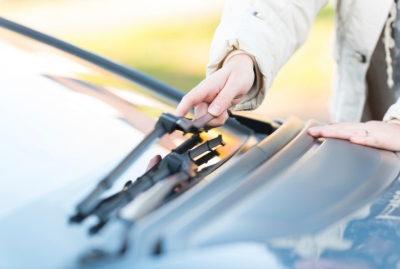This post was originally published on www.geico.com
Well, you’ve done it. You’ve made it through winter and so has your car.
The change of season brings new challenges for your four-wheeled baby, as well as opportunities for you to let it shine—literally. It’s time to make sure your pride and joy is ready for the warmer months ahead. It’s time to de-winterize.

Check Tire Pressure
Adequate tire pressure is vital to maximizing handling and traction, while minimizing wear and tear. As the colder months rolled in, you were probably advised to check your tire pressure, or psi (pounds per square inch). You most likely noticed that the reading was a bit lower than normal and added some air. Now that the seasons are changing, you should check them again because as the outside temperature rises, tire pressure will naturally increase.
Remember to check your tire pressure before you start driving. Why? Because extended periods of driving mean more and more friction between your tires and the road, which leads to increased heat and, therefore, higher tire pressure. You want to make sure you get an accurate tire pressure reading not altered by such increases before adjusting the psi accordingly. Be sure to keep an eye on this as the months go on because the hotter it gets, the higher your tire pressure will climb, and one of the last things you want on your hands is a blown tire.

Change Oil & Viscosity
It’s always a good idea to change your oil regularly, not only at specific mileage intervals, but also after significant wear on your car such as that from a long road trip or a grueling winter—both of which can be extremely hard on your engine. Engine oil viscosity, or thickness, plays a vital role in properly lubricating internal parts of the engine and works differently under certain circumstances. Some vehicle engines allow you to use one of several viscosities of oil, depending on climate conditions. For example, your owner’s manual may instruct you to use “either 5w-20 or 0w-20.” The thinner oil, in this case 0w-20, that you may have used in the winter to assist in starting your engine in freezing temperatures should now be replaced with the thicker 5w-20 viscosity to ensure proper lubrication and functionality. Always be sure to refer to your owner’s manual for an appropriate viscosity range.

Get An Alignment & Wheel Balance
When you do get your oil changed for the first time after winter, be sure to get an alignment and balance check while you’re at it. Depending on where you live, your car may have been subjected to some pretty horrendous potholes, which can be exacerbated by the freezing and warming temperatures. These can be a car’s (and car owner’s) worst enemy—not only can they damage a tire’s tread, but they can really throw its entire weight off and possibly even damage the rim itself. Proper wheel balance and alignment will end up saving you hundreds down the road by maximizing fuel economy, preventing further wear and tear, and more importantly, ensuring your safety. Check out 5 Signs You Need New Tires to find out if it’s time to replace them altogether.

Do A Thorough Wash & Wax
Taking the time to properly wash and wax your car after winter is more than just an attempt at keeping it looking good. Salt and other chemicals spread over the streets to prepare for icy conditions make their way into your wheel well and even against your car’s undercarriage. Left alone, these chemicals can eat away at critical parts and, ultimately, deteriorate their functionality. Keep your eyes open for a good car wash that includes an undercarriage service as part of the package. It won’t hurt to wash the car again by hand afterwards, just to make sure you don’t miss any dirt or salt on the surface of the vehicle’s paint or inside the wheel well. (Check out these Surprising Car Washing Dos and Don’ts for more valuable tips.)
Waxing your car is the next best step you can take to preserve your ride’s paint and prevent both premature corrosion and fading. The benefits are two-fold—it acts as a revitalizer after the harsh winter elements and also helps brace your paint for the coming heat and sunlight. Optimal conditions for a great wax are:
- between roughly 70°F and 80°F – so your wax will bond to the clear coat without hardening prematurely,
- out of direct sunlight – so the wax doesn’t dry up before you have a chance to buff the excess away, and
- out of heavy wind – to keep debris and dirt from sticking to your car’s surface as you buff.
Visit your local auto supply store and ask an associate to recommend the best wax type and consistency for your paint’s current condition.

Check Your Wiper Blades
Lastly, don’t forget to check your wiper blades. Ice and salt can do a number on the rubber edges of your blades—everything from minor deterioration to more prominent tears along their span. An easy way to assess any damage is to test them after wetting your own windshield. You need to ensure that the blades are making full contact with the glass of the windshield and that all surfaces they slide across are being properly dried as you intend them to. You want to make sure they are in peak working condition before you get caught driving in those April showers we all know are right around the corner. (Check out Car Maintenance 101: How to Replace Wiper Blades for easy installation instructions.)
Hopefully, you spent a little time preparing your ride for the cold and icy conditions of winter. The season itself has thrown a couple curve-balls your way, some of which you may not have anticipated, but it doesn’t take much to make small adjustments that will ensure a safe, smooth transition into spring.
While you’re doing spring cleaning on your car, do a spruce-up of your auto insurance policy, too. Find out how much GEICO could save you with more ways to save on car insurance.
By Steven Scott
Next article: Surprising Car Washing Dos and Don’ts
[ad_1]
